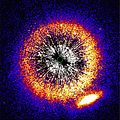File:Viewing the Vermin Galaxy.jpg

File originale (1 244 × 1 242 pixel, dimensione del file: 892 KB, tipo MIME: image/jpeg)
| Questo file e la sua pagina di descrizione (discussione · modifica) si trovano su Wikimedia Commons (?) |
Dettagli
| DescrizioneViewing the Vermin Galaxy.jpg |
English: The NASA/ESA Hubble Space Telescope is famous for its jaw-dropping snapshots of the cosmos. At first glance this Picture of the Week appears to be quite the opposite, showing just a blur of jagged spikes, speckled noise, and weird, clashing colours — but once you know what you are looking at, images like this one are no less breathtaking.
This shows a distant galaxy — visible as the smudge to the lower right — as it begins to align with and pass behind a star sitting nearer to us within the Milky Way. This is an event known as a transit. The star is called HD 107146, and it sits at the centre of the frame. Its light has been blocked in this image to make its immediate surroundings and the faint galaxy visible — the position of the star is marked with a green circle. The concentric orange circle surrounding HD 107146 is a circumstellar disc — a disc of debris orbiting the star. In the case of HD 107146 we see the disc face-on. As this star very much resembles our Sun, it is an interesting scientific target to study: its circumstellar disc could be analogous to the asteroids in our Solar System and the Kuiper belt. A detailed study of this system is possible because of the much more distant galaxy — nicknamed the “Vermin Galaxy” by some to reflect their annoyance at its presence — as the star passes in front of it. The unusual pairing was first observed in 2004 by Hubble’s Advanced Camera for Surveys, and again in 2011 by Hubble’s Space Telescope Imaging Spectrograph. The latter image is shown here, as the Vermin Galaxy began its transit behind HD 107146. The galaxy will not be fully obscured until around 2020, but interesting science can be done even while the galaxy is only partly obscured. Light from the galaxy will pass through the star’s debris discs before reaching our telescopes, allowing us to study the properties of the light and how it changes, and thus infer the characteristics of the disc itself. |
| Data | |
| Fonte | https://www.spacetelescope.org/images/potw1722a/ |
| Autore | ESA/Hubble & NASA |
Licenza
| ESA/Hubble images, videos and web texts are released by the ESA under the Creative Commons Attribution 4.0 International license and may on a non-exclusive basis be reproduced without fee provided they are clearly and visibly credited. Detailed conditions are below; see the ESA copyright statement for full information. For images created by NASA or on the hubblesite.org website, or for ESA/Hubble images on the esahubble.org site before 2009, use the {{PD-Hubble}} tag.
Conditions:
Notes:
|
- Tu sei libero:
- di condividere – di copiare, distribuire e trasmettere quest'opera
- di modificare – di adattare l'opera
- Alle seguenti condizioni:
- attribuzione – Devi fornire i crediti appropriati, un collegamento alla licenza e indicare se sono state apportate modifiche. Puoi farlo in qualsiasi modo ragionevole, ma non in alcun modo che suggerisca che il licenziante approvi te o il tuo uso.
Didascalie
Elementi ritratti in questo file
raffigura
29 mag 2017
Cronologia del file
Fare clic su un gruppo data/ora per vedere il file come si presentava nel momento indicato.
| Data/Ora | Miniatura | Dimensioni | Utente | Commento | |
|---|---|---|---|---|---|
| attuale | 23:04, 29 mag 2017 |  | 1 244 × 1 242 (892 KB) | Huntster | Use default resolution rather than the stretched screen resolution version. |
| 16:16, 29 mag 2017 |  | 1 280 × 1 278 (495 KB) | Jmencisom | User created page with UploadWizard |
Pagine che usano questo file
La seguente pagina usa questo file:
Utilizzo globale del file
Anche i seguenti wiki usano questo file:
Metadati
Questo file contiene informazioni aggiuntive, probabilmente aggiunte dalla fotocamera o dallo scanner usati per crearlo o digitalizzarlo. Se il file è stato modificato, alcuni dettagli potrebbero non corrispondere alla realtà.
| Crediti | ESA/Hubble & NASA |
|---|---|
| Fonte | ESA/Hubble |
| Titolo breve |
|
| Descrizione dell'immagine |
|
| Termini di utilizzo |
|
| Data e ora di creazione dei dati | 06:00, 29 mag 2017 |
| Data e ora di modifica del file | 11:23, 28 nov 2016 |
| Data e ora di digitalizzazione | 14:01, 24 nov 2016 |
| Data in cui i metadata sono stati modificati l'ultima volta | 12:23, 28 nov 2016 |
| ID univoco del documento originale | xmp.did:c4ffb57f-57b6-2047-ba9e-b34a0d3db06a |
| Parole chiave | Vermin Galaxy |
| Informazioni di contatto |
Karl-Schwarzschild-Strasse 2 Garching bei München, , D-85748 Germany |
| Versione IIM | 4 |


